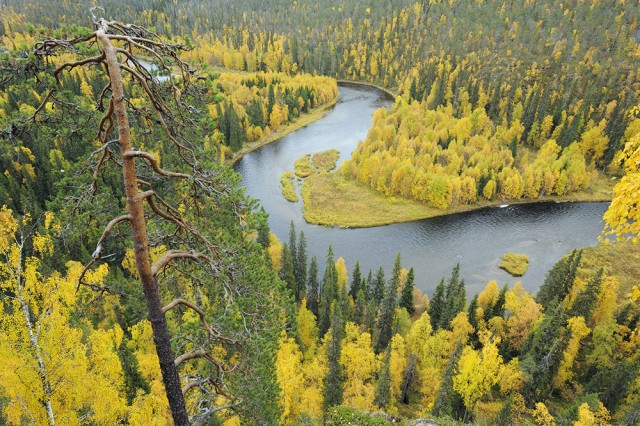taiga
THE FORESTS OF THE world occur in several climatic zones, which range from the subpolar to tropical regions. The taiga is the name given to the forests that border the tundra meadows and dwarf shrublands of polar latitudes where annual temperature regimes prohibit the growth of trees. These forests are dominated by coniferous species.
The name derives from the Russian word for “land of little sticks,” which reflects the impact of climate on tree growth in continental interiors. The greatest extent of taiga occurs in the Northern Hemisphere because of the greater expanse of land between northern latitudes 50 degrees N and 70 degrees N as compared with the domination of ocean in equivalently located southern latitudes. The taiga forms a forest belt across North America and Eurasia, with the tundra on its northern border and the temperate forests and grasslands to the south.

This BIOME is often referred to as the boreal zone though in northern CANADA there are also large expanses of muskeg, a type of wetland/peatland, within the forest. These northern forests occupy some 6.1 million square mi (15.8 million square km); a further .2 million square mi (.5 million square km) of coniferous forest extends along the ocean coast from ALASKA to CALIFORNIA.
Climatic conditions in these regions vary enormously, from harsh continental to more favorable northern maritime regimes. Overall, cold, dry conditions prevail along with a big range of temperature; average temperatures of -22 degrees F (-30 degrees C) occur during the winter, while the average temperature in the summer months is 59 degrees F (15 degrees C). There is a growing season that varies from only 50 days in continental interiors to 100 days in southerly and near coastal regions. The risk of frost is high even during the summers which are characterized by a long day, and the change of seasons tends to be abrupt.
Precipitation is on average 20 in (50 cm), but amounts also vary considerably; coastal areas of Scandinavia and the west coast of North America receive up to 80 in (200 cm). Most precipitation falls as rain in the summer months with some precipitation falling as snow in the winter. The harsh conditions affect soil type in the taiga, which was either directly glaciated or experienced polar desert conditions during the last ice age. Glacial and periglacial deposits are the substrates on which young soils have developed. These are often sandy and acidic with some organic material rich in lignin from accumulating coniferous needles.
Permafrost also occurs but is discontinuous, and the operation of freeze-thaw cycles in soils causes soil movement and the formation of hummocks and hollows. The hollows are favored by trees, mosses, and shrubs, and the hummocks by lichens. Naturally occurring fire plays a significant role in taiga dynamics. Many conifers require fire to release seeds from their cones, and fire promotes new growth.
The dominant taiga tree type is the conifer with needlelike leaves. Most species are evergreen, which means that they shed needles year-round, the main exception being the larches that dominate the vast expanses of SIBERIA. These are deciduous, which means that they shed their leaves annually. Worldwide, the taiga is a considerable store of carbon, both within the living trees and within the organic material of the soils that derives from the trees. Although there are similarities in the structure or physiognomy of the plant communities in this biome, there is considerable variation in the species composition.
In North America, white spruce, black spruce, and tamarack (a species of larch) are the most widespread, but many other species occur where climatic, topographic, or soil conditions are favorable. Shrubs, grasses, sedges, herbs, lichens, and mosses are also common in taiga communities, while large herbivores, for example, caribou in North America and reindeer in Eurasia, are the most conspicuous animals. A wide range of insects also characterizes the taiga, and sometimes population outbreaks can cause significant defoliation.
Taiga communities can also be classified according to their relationships with adjacent communities. There are four zones, as follows:
- Forest-tundra (transitional zone between the two major biomes): Stunted trees in isolated stands, lichenand moss-dominated communities.
- Open taiga (boreal woodlands): Discontinuous stands of trees and shrubs with lichens and mosses.
- Closed taiga (boreal woodlands): Continuous stands of trees with a closed canopy, a shrub understory.
- Taiga-mixed forest or taiga-grassland (transitional zone with southern ecosystems of the temperate forest of grassland): Mixed forests of conifers and deciduous hardwoods or a mixture of conifers in grassland.
Economically, the taiga forests are very important. They provide the raw materials for forestry industries in Canada, the UNITED STATES, Scandinavia, and RUSSIA and are the source of considerable wealth generation. The major products are roundwood, sawnwood and pulp for paper making. Canada is the leading producer of wood products from its forests.
However, much forest exploitation is unsustainable, especially where large tracts of land are left treeless by clear felling. The situation is particularly serious in eastern Siberian forests, which are diminishing rapidly. The plight of the taiga rarely achieves the publicity attention or media interest garnered by tropical RAINFORESTS.